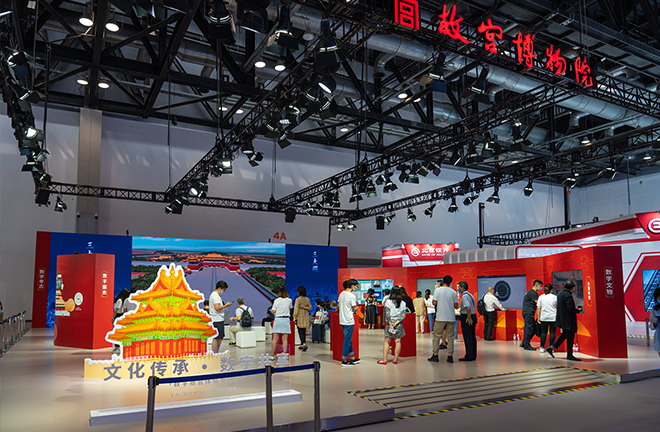Museums seek new paths for cultural transmission

A digital Palace Museum displayed at the China International Fair for Trade in Services in Beijing, Sept. 4 Photo: CFP
As an instrumental platform for cultural dissemination and public learning, museums, through exerting their role of social education and guidance, serve to cultivate the public’s awareness and sense of responsibility concerning sustainable development.
UNESCO enacted and adopted the “Recommendation Concerning the Protection and Promotion of Museums and Collections, their Diversity, and their Role in Society” in November 2015, highlighting that museums should be supported in utilizing information technology to share and disseminate knowledge and better fulfill their key functions. Building upon social advancements and concept-changing museums in recent years, new technologies have increasingly penetrated into museum-related exhibition, interpretation, and research.
Digital display
From the electric age to the information age, it has always been the primary pursuit of museums to facilitate the opening of cultural resources and the sharing of knowledge. Seen in the context of developmental trends of museums across the globe, it has become common to open digital cultural resources to the public. Liu Shuguang, chairman of the China Museums Association, said that within the current social background, new media communication forms in museums, typical of online exhibitions, online cultural relics databases, live online tours, and online education courses, are widely welcomed by the public.
New media and new technology push the display designs of museums to develop towards flat design, three-dimensionality, and spatialization. Hu Weijun, a professor from the School of Archaeology at Jilin University, said that impacted by the COVID-19 pandemic, museums have been faced with unprecedented, albeit temporary, closures, resulting in the emergence of new models, such as live streaming. With the constant innovation of new media platforms such as WeChat official accounts, official Weibo accounts, and Douyin, new modes of communication such as live broadcasting have altered access to museums, lifting the speed, strength, and breadth of museum information dissemination.
Lu Jiansong, a professor from the Department of Cultural Heritage and Museology at Fudan University, took the Red Culture-themed museums in Shanghai as an example to analyze the impact of information technology on the information dissemination of museums. In his view, these museums have stored, retrieved, and delivered myriads of information. They break through and transform the traditional display method of cultural relics plus textual explanations, creating a multi-sensory method of information dissemination and vividly reproducing Red Culture. Being more participatory, interactive, and interesting to viewers, these platforms encourage more visits and active learning, extending the exhibition and teaching space through the internet plus various public platforms.
Ways forward
As museums have come “alive” amid fast-growing new media and technology, however, some explicit and implicit problems have gradually arisen in the operation of museums. Lu added that the dissemination of the above-mentioned museums should dig deeply into the stories and spirits behind Red Culture and pertinent cultural relics. The red spirit needs to be extracted from these cultural resources to consolidate the dissemination foundation of Red Culture. It is necessary to work effectively in the planning and scriptwriting of new media content, locating the key for spreading Red Culture, and transforming research results into cultural communication content favored by the audience.
Wherever new media is applied to museums, however, digital technology will also bring potential intellectual property risks. On the one hand, digitized museum collections might encounter the risk of infringing on others’ intellectual property rights; on the other hand, the display of digital collections increases the risk of the museum’s IPR being infringed upon.
In this regard, Hu suggested doing our utmost to serve the dual purposes of reasonable copyright use and infringement risk prevention in the whole digitization process of museum collections. Before digitizing museum collections, it is necessary to confirm and check copyrights to prevent infringement of registered copyrights. In the meantime, we need to abide by the interactive relationship between technology and law, introduce block-chain technology, and crack the problem of the copyright usage of “orphan works” in museum collections. For some digital museum collections entering the public-owned domain, marketing strategies can be employed to better expand the degree of open access, so as to make traditional culture more prominent in the era of digital copyright and aid museums in accumulating more digital copyright wealth.
At present, the rapid development of new media technology is changing the traditional information transmission mode as well as the business structure of museums, Liu concluded. Museums, which carry multiple functions including collection, protection, research, and education, should strive to follow the general trend of new media, adjust and expand traditional functions, and improve user experience, constantly seeking new modes of cultural communication.
